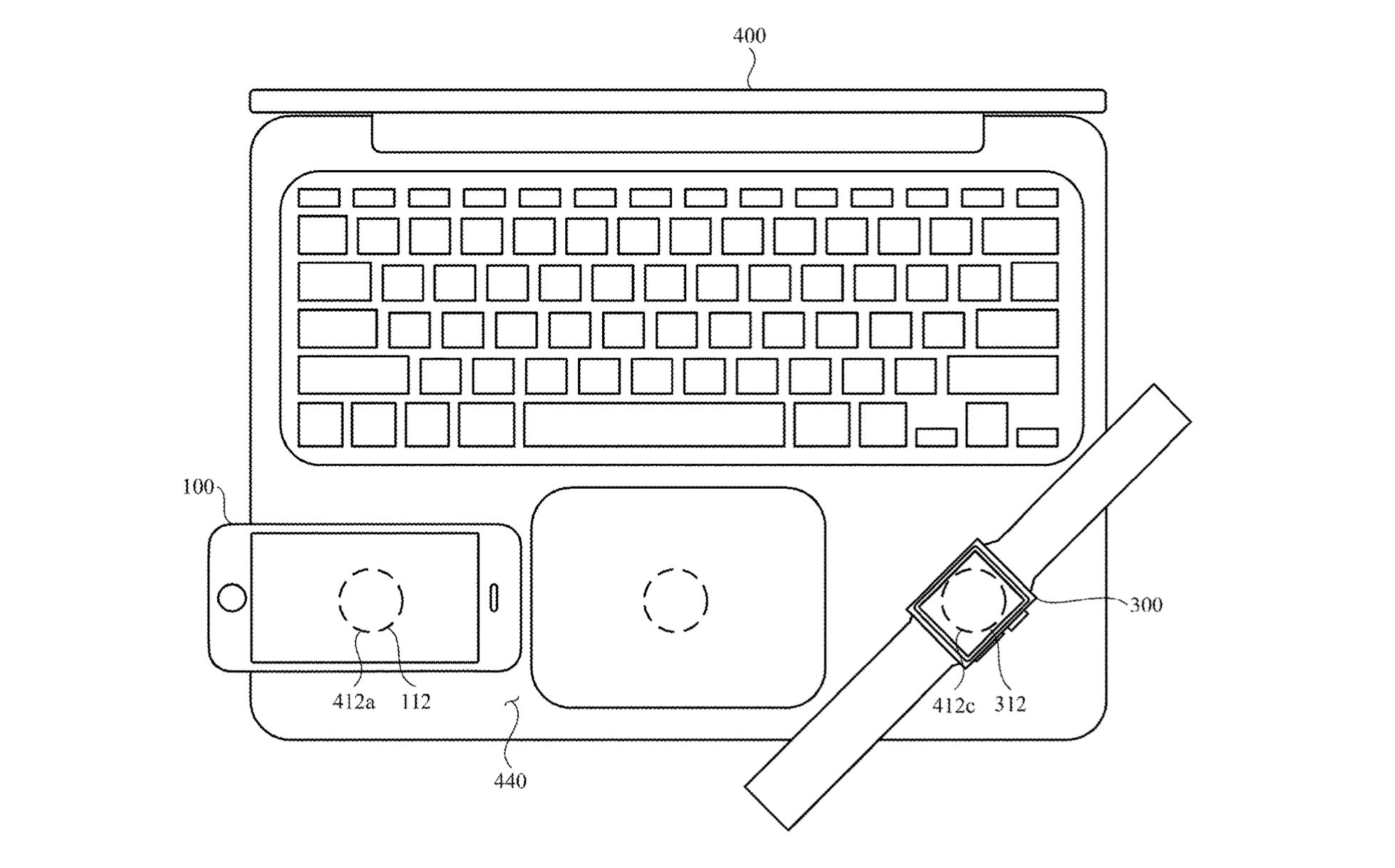
Apple is researching the integration of multiple inductive charging coils into MacBooks and iPads to use as wireless chargers for other devices, according to a patent filed by Apple.
/article-new/2021/01/device-inductive-charging-patent-macbook.jpg?resize=560%2C349&ssl=1)
The patent, spotted by Apparently Apple, is entitled “Inductive Charging Between Electronic Devices” and was awarded by the US Patent and Trademark Office.
Apple has been investigating device-to-device inductive charging technology since March 2016, when the now-granted patents surrounding it were first filed. It is noteworthy that Apple appears to be particularly interested in this area, having filed multiple patents related to the technology, and it has now filed 40 new claims.
This patent shows how all Apple mobile devices, including Apple Watches, iPhones, iPads and MacBooks, can together use a wireless charging ecosystem. Images included in the patent show a significant number of different coil placements for a range of portable Apple devices to facilitate this system.
Apple presents a wide variety of possible implementations for wireless charging from device to device. For example, the lid of a MacBook may contain a series of upward-facing inductive coils, which allow devices to be charged by resting on them. Coils can also be placed on the palm rests and trackpad of a MacBook.
Crucially, the wireless charging system is a two-way street, with devices capable of both receiving and transmitting power through inductive coils, allowing users to choose which device to charge. It can also be automatically determined by software based on which device has a greater amount of charge.
The strategy proposed by Apple seems to be to include carefully placed inductive charging coils on any Apple mobile device. For example, the patent explains how to place coils along both the front and back of an iPad so that it can be charged wirelessly from one end and the charge sent to another device on the other. The proposed system is therefore highly interchangeable, with an enormous number of device combinations and placements possible.
It has even been suggested that a collection of Apple devices can be charged together from one power source. An image shows an Apple Watch charging from an iPhone, the iPhone from an iPad, the iPad from a MacBook, and the MacBook via a power cable. The text accompanying the figure states “only a single power supply cable or no power supply cables may be required to charge one or more of a group of devices containing electrically communicative inductive coils”.
/article-new/2021/01/device-inductive-charging-patent-all-devices.jpg?resize=560%2C300&ssl=1)
/article-new/2021/01/device-inductive-charging-patent-all-devices.jpg?resize=560%2C300&ssl=1)
/article-new/2021/01/device-inductive-charging-patent-all-devices.jpg?resize=560%2C300&ssl=1)
/article-new/2021/01/device-inductive-charging-patent-all-devices.jpg?resize=560%2C300&ssl=1)
Apple has also considered an assortment of software integrations for the device-to-device wireless charging system. When a smaller device is placed on the screen of a larger device, such as an Apple Watch on the front of a iPad, the iPad screen can indicate the “alignment condition” and charge percentage.
Another more inventive software integration proposes that, if the screen of an iPad is blocked by charging an kaniPad, the iPad’s user interface can be modified to display content only on the unobstructed part of the screen. There are also features for scenarios where the iPhone can be used to display the content that is blocked on the appsiPad screen, such as a row of apps on the home screen.
/article-new/2021/01/device-inductive-charging-patent-iphone-on-ipad-apps.jpg?resize=560%2C399&ssl=1)
/article-new/2021/01/device-inductive-charging-patent-iphone-on-ipad-apps.jpg?resize=560%2C399&ssl=1)
/article-new/2021/01/device-inductive-charging-patent-iphone-on-ipad-apps.jpg?resize=560%2C399&ssl=1)
/article-new/2021/01/device-inductive-charging-patent-iphone-on-ipad-apps.jpg?resize=560%2C399&ssl=1)
The patent also repeatedly refers to a system of magnets that can be used to line up devices for charging, which is strikingly similar to Apple’s MagSafe system that premiered with the iPhone 12 series.
In some embodiments, the electronic device includes an alignment magnet located adjacent to the inductive coil. The alignment magnet can be configured to assist in positioning the remote device relative to the electronic device …
The patent implies that this magnetic alignment system can be used on any of its portable devices to support a better wireless charging experience, and it would certainly make sense to expand MagSafe or a MagSafe-like system to more devices to support this ecosystem of devices Inductive charging to the device. MagSafe is currently only available on iPhone 12 and iPhone 12 Pro.
If Apple incorporated the proposed technology, it would create a unified wireless charging system for all portable Apple devices. The device-to-device inductive charging system seems feasible and would help Apple synthesize its otherwise fragmented array of charging methods, but it’s not clear how Apple would address the inevitable thermal, penetration, or efficiency issues it would create.
The arrival of “MagSafe” charging on the “iPhone 12” demonstrates Apple’s interest in wireless charging solutions, and the depth of the company’s research shows the depth of thought about such systems. Despite this, patents can only serve as evidence of what Apple is investigating. They do not necessarily specify what the company can implement and the content of many patents never ends up in end products for consumers.